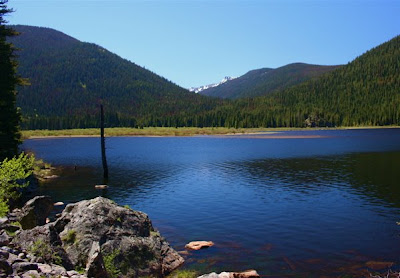Elevation: 10,100-10,940 ft
Elevation Gain: 840 ft

Diamond Lake is a wildflower Mecca with hordes of shutter bugs circling round and around choice Columbine and Indian paintbrush much like Muslims orbit the Kaaba shrine. Depending upon when you go, you can find flowers lower down near the trailhead or up higher in the large meadow that borders the lake. Go too early e.g. May and June and you will end up trodding through large drifts of snow and soggy expanses of melt water. The lake itself can be shrouded in dark clouds at this time too, which does create its own photo opportunities. I suggest waiting until mid-July, however if you want to wallow in wildflowers.

Be emotionally prepared to feel the press of humanity if you join the Hajj on weekend. Not only must you get to the parking area very early, but also you will be bumped and prodded by the multitudes trodding by. The Fourth of July trailhead is also the starting point for Dorothy Lake and Arapahoe Glacier so for part of the route you will be joined by more serious hikers. Lake is stocked as well, so anglers join the procession to the lake, some carrying inflatable dinghies to float in.

The trail begins to climb right off the bat and the hiker will traverse small meadows and forested slopes. Flowers exist in both places so keep your eyes open for more rare finds. There are several water crossings that are not arduous and which attract their own flock of water loving flower species like the ubiquitous Chiming Bells, which grow in huge clumps anywhere there is water.

At 1.2 miles the trails splits. Take the left fork and continue until you reach a pleasant waterfall. At this point the trail bends back upon itself and heads back down the valley. I find this feature frustrating and don’t know why the trail does just head straight up to the lake with out looping back. This is a psychological impediment I know. It is hard for us driven Americans to ever think of going backwards. This back tracking is also the steeper portion of the trail. It is in a darker forest with fewer views. Early in the season this is also where the snow can linger.

At the top of this steep pitch is a broad meadow with logs strategically placed to protect the sensitive plants. The views return at this point but it is best to sally to the lake where there are plenty of places to sit and snap pictures. I particularly like the stunted conifers here, which are wind blown and artistic. Their flag shapes are testament to the winds that flow down the valley from the north. On more than one trip to the lake, I have been hailed on, so bring rain gear even if the weather is pleasant in the morning.

Like the participants in the Hajj, you will be spiritually renewed by your journey to Diamond Lake and if you can go on a weekday, then you will reach this renewal without paying the price without having to follow the butt of the person in front of you.



















































